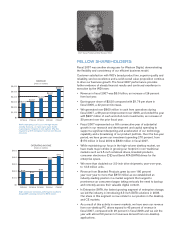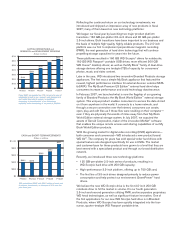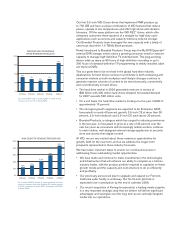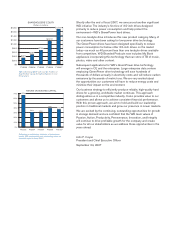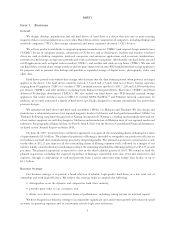Western Digital 2007 Annual Report Download - page 12
Download and view the complete annual report
Please find page 12 of the 2007 Western Digital annual report below. You can navigate through the pages in the report by either clicking on the pages listed below, or by using the keyword search tool below to find specific information within the annual report.• the increasing needs of businesses and individuals for increased storage capacity on their notebook computers;
• the continuing development of software applications to manage multimedia content; and
• the increasing use of broadband Internet, including content downloaded from the Internet onto notebook hard
drives.
We expect the mobile PC market to continue to grow faster than the desktop or enterprise markets in the next three
years. As the mobile PC market continues to evolve to a higher volume market, we believe customers are placing
increased emphasis on attributes such as quality, reliability, execution, flexibility, and competitive cost structures of their
hard drive suppliers. These are the same attributes that have mattered for many years to customers in the high-volume
desktop market.
Enterprise Market
The enterprise market for hard drives includes workstations, servers, network attached storage, storage area
networks, other computing systems or subsystems, and video surveillance. Historically, hard drives for this market have
utilized several interfaces, including the Small Computer Systems Interface (“SCSI”) and Fibre Channel Arbitrated Loop
(“FCAL”). Beginning in 2003, these traditional enterprise interfaces have been supplemented or have been replaced in
certain storage applications by hard drives featuring the SATA interface technology, which is supported by industry
standards, as well as by Serial Attached SCSI (“SAS”). SATA hard drives typically cost customers less than SCSI hard
drives while offering higher capacities and maintaining similar reliability, scalability and performance.
We believe that enterprise uses of SATA hard drives will continue to increase. During the past few years a new disk-
based back-up application has emerged with high-capacity SATA hard drives augmenting SCSI hard drives, tape and
optical media. This new application, popularly referred to as “near-line” storage, has created a growth market because
hard drives back-up or access data more quickly than tape or optical solutions, and quickly retrieve critical back-up or
near-line data. The availability of SATA hard drive solutions, which are more cost effective than SCSI hard drives,
promotes the increasing use of high-capacity hard drives in near-line storage applications. The low price per capacity of
SATA drives has stimulated new applications such as video surveillance, video editing/broadcasting and medical
imaging. These applications represent segments of a growing market for high capacity storage in non-computing
imaging and multimedia professions.
Enterprise-class SATA drives are becoming commonplace for IT infrastructure applications such as databases,
scientific computing, web content, web caching, web search engines and electronic mail. These applications have become
an important market for high-capacity SATA hard drives. We believe that this market will consume a growing portion of
the highest capacity hard drives in the next three years.
SAS is the next generation SCSI technology and is expected to replace SCSI drives over the next few years. SATA
technology is compatible with SAS technology, enabling customers the flexibility of incorporating SATA hard drives in
SAS storage systems. We believe the market transition from SCSI to SAS will add to the growth of the enterprise-
class SATA market, which currently is estimated to be more than 30% of the enterprise hard drive market.
High-performance applications such as blade servers are increasingly using 2.5-inch form factor hard drives,
supplanting traditional 3.5-inch drives. Smaller form factors enable more drives per physical space for increased
performance, high capacity per square foot and low power consumption. This trend demonstrates the fragmentation of
the enterprise hard drive market and the need for application-specific enterprise-class hard drives.
Consumer Electronics Market
The use of hard drives in CE products has been a major growth area in recent years. Currently, the three largest
segments of this market are:
• video content in applications such as DVRs;
• audio and video content in applications such as consumer handheld devices, including MP3 players; and
• hard drives in game consoles.
6



